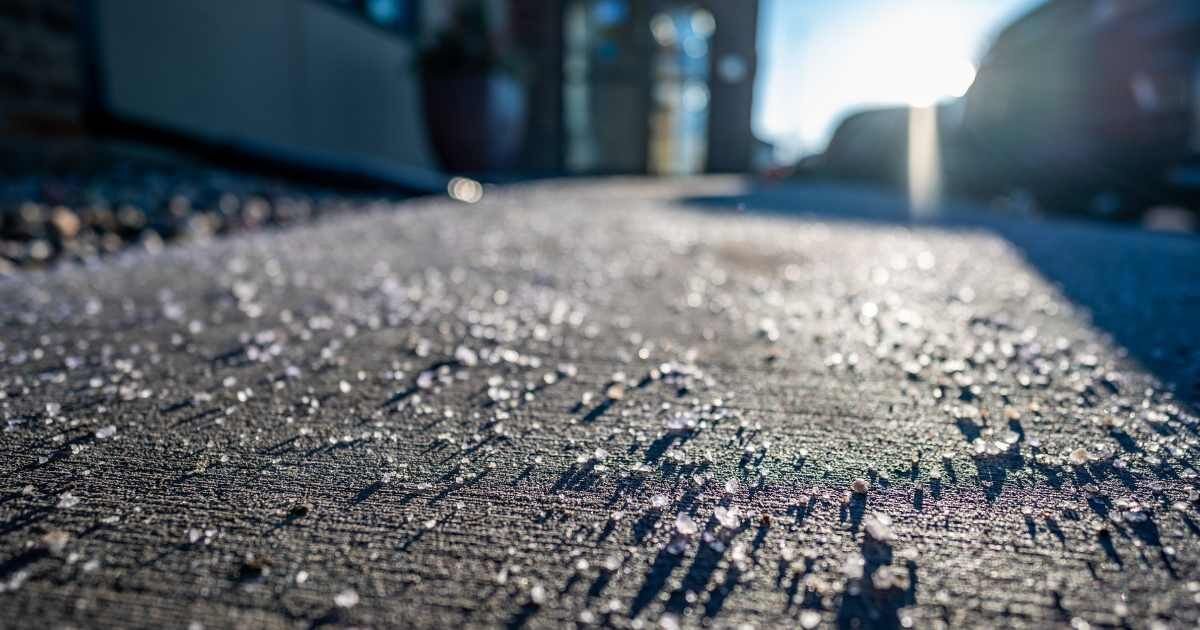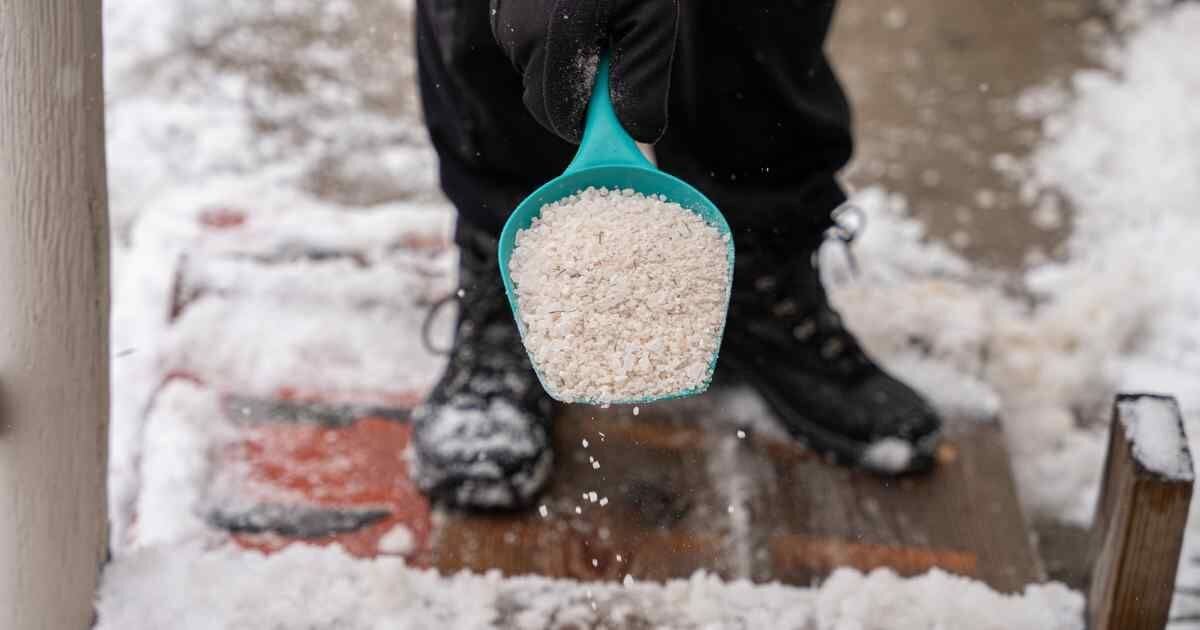
We collect basic website visitor information on this website and store it in cookies. We also utilize Google Analytics to track page view information to assist us in improving our website.
 Show your Canadian pride with our Canada-Themed Displays >>
Show your Canadian pride with our Canada-Themed Displays >> 

Many people work from home these days, but many still have to travel for work or simply have errands to run. However, this new year, sustainability is at the top of your mind, and this can be a big concern in the winter when the use of salt is quite common.
We're already in February, so the month's theme is sustainability. How can your city use salt sustainably? Let’s explore the subject together.
Classic Displays may be known for our commercial holiday decorations, but we also provide many practical site furniture items, including salt storage bins, that you may see around the city.
In this blog post, we’ll interchangeably refer to salt as “road salt” and just “salt.” This is to ensure there’s no confusion. Just know we’re not referring to the salt you eat!
Road salt is made primarily of sodium chloride and is used to melt ice on roads for public safety. While it's a useful tool, misuse can cause poor environmental impact. It has the potential to contaminate soil, disrupt plant growth, and damage the aquatic ecosystem by increasing water salinity. Also, salt can corrode local infrastructure, including bridges and vehicles, requiring additional maintenance costs.
In order to actually use road salt sustainably, it's important for the city to apply it minimally. Rather than oversaturating the city, having access to road salt in high-risk areas is a must, and road salt should be used based on the severity of the weather.
Pre-treating roads prior to severe weather like snow storms and freezing rain increases its effectiveness while decreasing salt waste. It's also essential for the city to educate the community on responsible road salt usage and encourage alternative de-icing methods to help balance safety and environmental protection.
But let’s take a deeper dive into sustainable salt usage.
Road salts include a lot of compounds that can be broken down into chloride salts. Basically, this means road salt is a combination of chloride mixed with an element, including sodium, calcium, magnesium, or potassium.

Here are some other elements as well as alternatives that can be used in place of road salt:
Calcium Chloride (CaCl₂)
Effective at lower temperatures
Less corrosive than sodium chloride
Magnesium Chloride (MgCl₂)
Works at low temperatures
Less corrosive than calcium chloride
Potassium Chloride (KCl)
Less corrosive to vehicles and infrastructure
Better for plants
Sand
Provides traction on ice
Environmentally friendly and inexpensive
Urea
Less corrosive than road salt
Commonly used in fertilizers
Ash
Provides traction
Inexpensive and environmentally friendly
Acetate-Based Products (e.g., CMA)
Less corrosive
Safer for vegetation
Rice Hulls
Non-toxic and renewable
Provides traction
Vinegar
Inexpensive and non-toxic
Requires frequent reapplication
According to Queen’s University, there are even more eco-friendly options being tested; beet water (leftover from processing sugar beats), cheese brine, pickle juice, and potato water are unconventional de-icing options being tested.
In the meantime, it's better to use road salt safely and sparingly, instead focusing on other key steps to help prevent accidents caused by ice – such as preparing for the weather and applying salt only as needed.
When misused, road salts can hurt the environment when they leak into bodies of water, such as lakes and rivers. This often happens when roads or walkways are close to slopes and melting snow runs off into the water. It can also make its cycle by leaking into the stormwater system.
Road salts alter the water's base chemistry, meaning it can quickly become toxic to aquatic life and other mammals such as birds. Any animal that consumes the water could be at a direct risk of becoming poisoned.
Unfortunately, any salt that has already been laid down can't be removed. Road salt melts easily when exposed to water, and with no easy way to collect or redistribute it before it evaporates, it's just not realistic. Instead, it's better to focus on using salt more responsibly in the future.
Here are a couple of ways you can help manage your city's salt use in the future:
Shovel snow right away and be thorough to avoid ice from forming:
If the snow is thick enough, remove the snow with a shovel to avoid having to use salt if you can. You can also sometimes use a shovel to break up ice.
Use alternatives such as sand or non-toxic cat litter to provide traction on slippery surfaces:
Keep in mind that this won't melt the ice, it's just there to help provide traction.
If you don’t have access to alternatives, use road salts sustainably:
When you don’t have any other options, it’s still considered much safer to use road salts than to not use them at all. It’s important to be considerate when you decide to lay road salt. Make sure you’re only applying as absolutely necessary, particularly at the right temperatures (between 0°C and -10°C - or freezing temperatures). Salt should never be used to melt snow unless you’re in a limited or extreme circumstance. Snow is removable with several tools from shovels to snow blowers.
Use road salt products that have smaller grains as they spread easier and work faster – meaning you can use far less product without compromising quality. Store any leftover grains in an accessible spot for communal use.
Train city staff on proper salt treatment methods to equipment operators, city crews, and drivers:
Get city employees involved by teaching them sustainable salt practices and encouraging them not to overuse the product.
Maintain salt spreading equipment:
Keep up with regular maintenance of salt-spreading equipment to ensure the calibration isn’t out of whack, and make sure that your equipment isn’t in working order.
Keep your salting crews informed and up-to-date:
Make sure your team has detailed information on what areas are the main focus and ensure they have easy access to these areas.
Provide detailed reports on salt usage and sustainable approach:
Be transparent with your crews and the city community on salt usage and any additional sustainability efforts.
Inspect and invest in salt storage:
Make sure any salt storage bins around the city are intact and invest in high-quality products, such as the products supplied by Classic Displays.
Make your plans accessible to the public:
Provide an annual review of treatment efforts as well as key factors to plan for, identify, and implement improvements for the future.
Make your plans accessible to the public:
Provide an annual review of treatment efforts as well as key factors to plan for, identify, and implement improvements for the future.
Road salt, despite concerns about its environmental impact, is still the most reliable form of ice removal when it comes to ensuring the safety of the community. It's fast-acting, melts ice, and eliminates the possibility of accidents such as cars sliding or slips and falls.
For the time being, as alternatives are continually being explored, a step towards sustainability in the future is to use road salt sparingly and as needed. Make sure you keep an eye on the weather and prepare to use road salt sustainably before the bad weather hits.
While we’ve talked at length about the potential pitfalls of sustainable salt usage, there are a lot of positives if you do so correctly.
Reduces environmental impact
Protects water quality
Prevents soil degradation
Minimizes plant and wildlife damage
Reduces corrosion on infrastructure and vehicles
Lowers long-term maintenance costs
Improves public health and safety
Increases efficiency in salt use
Enhances sustainability in urban management
Promotes eco-friendly practices
Here are some additional tips and reminders on how to use salt sustainably this winter:
Use lower amounts of salt
Apply salt before snowfall
Use pre-treated salt solutions
Avoid using salt on warm surfaces
Use alternatives like sand or beet juice
Apply salt only where needed
Store salt properly to prevent runoff
Monitor weather conditions for optimal application
Use calibrated equipment for accurate spreading
Combine salt with other de-icing materials
Initially founded in 1977 as a small business that designed Christmas holiday displays for local city businesses, Classic Displays has grown exponentially in over 46+ years. Now, we're a multidivisional company that serves more than 350 municipalities, 150+ BIA groups, and several commercial properties.
Today, we offer more than just holiday display offerings: we have a myriad of site furniture that ensures the accessibility and safety of your community. Introduced in 1990, our Site Furniture division has been providing practical community beautifying products.
Don’t let your roads and sidewalks become unsafe this winter, and protect the integrity of your community with sustainable road salt usage. If you’re looking for additional community solutions, contact Classic Displays for our offerings today!
Stay safe out there, friends.